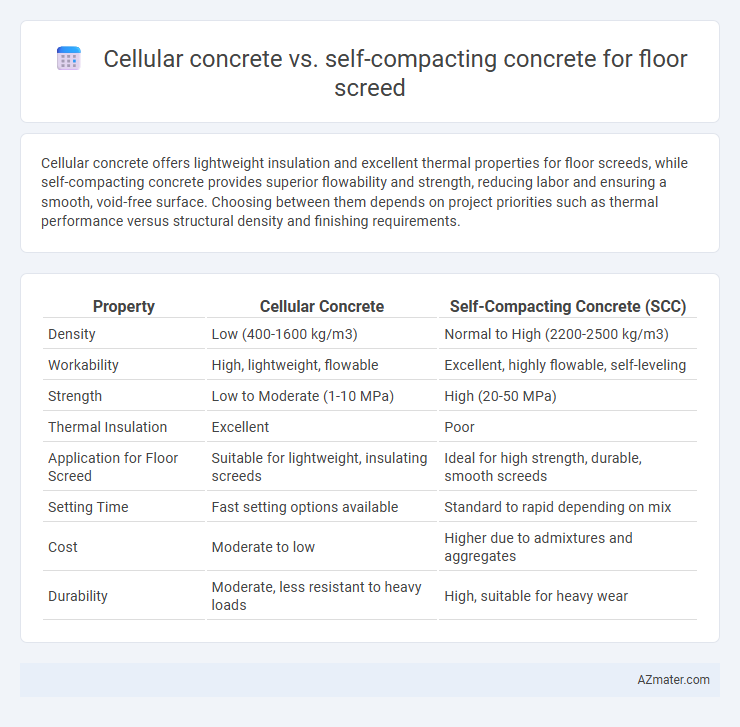Cellular concrete offers lightweight insulation and excellent thermal properties for floor screeds, while self-compacting concrete provides superior flowability and strength, reducing labor and ensuring a smooth, void-free surface. Choosing between them depends on project priorities such as thermal performance versus structural density and finishing requirements.
Table of Comparison
| Property | Cellular Concrete | Self-Compacting Concrete (SCC) |
|---|---|---|
| Density | Low (400-1600 kg/m3) | Normal to High (2200-2500 kg/m3) |
| Workability | High, lightweight, flowable | Excellent, highly flowable, self-leveling |
| Strength | Low to Moderate (1-10 MPa) | High (20-50 MPa) |
| Thermal Insulation | Excellent | Poor |
| Application for Floor Screed | Suitable for lightweight, insulating screeds | Ideal for high strength, durable, smooth screeds |
| Setting Time | Fast setting options available | Standard to rapid depending on mix |
| Cost | Moderate to low | Higher due to admixtures and aggregates |
| Durability | Moderate, less resistant to heavy loads | High, suitable for heavy wear |
Overview of Cellular Concrete and Self-Compacting Concrete
Cellular concrete is a lightweight, aerated material characterized by its low density and high thermal insulation, making it ideal for floor screed applications requiring reduced dead load and enhanced energy efficiency. Self-compacting concrete features high flowability and stability without segregation, enabling it to fill complex molds and spaces smoothly, ensuring uniform surface levels and eliminating the need for mechanical compaction in screed layers. Both materials offer distinct advantages: cellular concrete excels in insulation and lightweight construction, while self-compacting concrete provides superior workability and surface finish in floor screed installations.
Key Material Properties Comparison
Cellular concrete offers low density and excellent thermal insulation due to its air-entrained structure, making it ideal for lightweight floor screeds with enhanced energy efficiency. Self-compacting concrete provides superior workability and high flowability without segregation, ensuring a smooth, dense, and durable floor screed with minimal labor input. Key material properties highlight cellular concrete's reduced compressive strength compared to self-compacting concrete, which excels in mechanical strength and surface finish quality.
Application Methods for Floor Screeds
Cellular concrete for floor screeds is typically applied using pump systems or manual pouring, enabling lightweight, insulating layers with easy leveling properties. Self-compacting concrete relies on its high flowability and viscosity modifiers, allowing it to spread and compact under its own weight without the need for vibration equipment, ensuring a smooth, dense screed surface. Both methods require precise moisture control and curing conditions to achieve optimal strength and durability in floor screed applications.
Mixing and Placement Techniques
Cellular concrete for floor screed requires precise water-to-cement ratios and the incorporation of pre-formed stable foam to achieve its lightweight, aerated structure, demanding careful mixing to maintain foam stability. Self-compacting concrete (SCC) relies on high-flowability mixtures with optimized superplasticizer content, ensuring segregation resistance and uniform placement without mechanical vibration. Placement of cellular concrete involves pumping or pouring with gentle consolidation to preserve cellular integrity, whereas SCC is placed by direct discharge into formwork, flowing under its own weight to fill gaps and achieve a smooth surface finish.
Strength and Durability Performance
Cellular concrete offers lightweight properties with moderate compressive strength typically ranging from 1.0 to 7.0 MPa, making it suitable for non-structural floor screeds with good thermal insulation but lower durability under heavy loads. Self-compacting concrete (SCC) provides high strength performance with compressive strengths often exceeding 30 MPa and superior durability due to its dense microstructure and uniform compaction, ensuring enhanced resistance to wear, abrasion, and chemical attack in floor screeds. For applications demanding long-term durability and load-bearing capacity, SCC outperforms cellular concrete, whereas cellular concrete is preferred for lightweight, insulating screeds with lower strength requirements.
Thermal and Acoustic Insulation Capabilities
Cellular concrete provides superior thermal insulation with low density and high porosity, making it effective in reducing heat transfer in floor screeds. Self-compacting concrete offers enhanced acoustic insulation due to its dense and uniform microstructure, minimizing sound transmission through floors. Both materials improve floor screed performance, but cellular concrete excels in thermal insulation, while self-compacting concrete is preferable for noise reduction.
Workability and Finish Quality
Cellular concrete offers excellent workability due to its lightweight, aerated composition that allows easy pouring and leveling, making it ideal for floor screeds requiring thermal insulation and reduced load. Self-compacting concrete (SCC) exhibits superior flowability and can fill intricate formwork without vibration, resulting in a smooth, high-quality finish with minimal surface defects. While cellular concrete excels in thermal properties, SCC provides enhanced surface durability and uniformity, key factors for floors demanding precise finish quality.
Cost Analysis and Economic Considerations
Cellular concrete for floor screed typically offers lower material and installation costs due to its lightweight and simplified mixing process, reducing labor and transportation expenses. Self-compacting concrete incurs higher costs driven by specialized admixtures and more precise quality control requirements, which enhance workability and surface finish but increase initial investment. Economic considerations favor cellular concrete for budget-sensitive projects, while self-compacting concrete justifies its premium price through improved durability and reduced maintenance over time.
Environmental Impact and Sustainability
Cellular concrete offers superior thermal insulation and uses recycled materials, reducing carbon footprint in floor screed applications compared to traditional self-compacting concrete. Self-compacting concrete, while promoting ease of placement and reduced labor, often relies on higher cement content, contributing to increased CO2 emissions. Choosing cellular concrete enhances sustainability by minimizing energy consumption in heating and cooling due to its lightweight and insulating properties.
Choosing the Optimal Solution for Floor Screeds
Cellular concrete offers superior thermal insulation and lightweight properties, making it ideal for floor screeds requiring enhanced energy efficiency and reduced load on structures. Self-compacting concrete excels in flowability and uniform consistency, ensuring smooth, dense, and high-strength floor screeds with minimal labor and faster application. Selecting the optimal solution depends on project-specific priorities such as insulation, structural load limits, and installation speed for effective floor screed performance.

Infographic: Cellular concrete vs Self-compacting concrete for Floor screed
 azmater.com
azmater.com